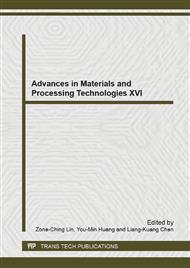[1]
E. Bayraktar, D. Katundi, A. Guinault, A. Kosecki, A. Larbi, Low Velocity Impact Behaviour of the Epoxy Matrix Composites Reinforced with Metallic and Oxide Particles, Dynamic Behavior of Materials, vol. 1, no. 1, pp.481-488, ed. Springer, (2013).
DOI: 10.1007/978-1-4614-4238-7_62
Google Scholar
[2]
Bai Y, Cheng Z-Y, Bharti V, Xu HS, Zhang QM. High-dielectric-constant ceramic powder polymer composites. Appl Phys Lett 2000; 25: 3804–6.
DOI: 10.1063/1.126787
Google Scholar
[3]
Kuo D-H, Chang C-C, Su T-Y, Wang WK, Lin B-Y. Behaviors of multi-doped BaTiO3/epoxy composites, Journal of Euro Ceram Soc 2001; 21: 1171–7.
Google Scholar
[4]
Wong CP, Bollampally RS. Thermal conductivity, elastic modulus, and coefficient of thermal expansion of polymer composites filled with ceramic particles for electronic packaging. J Appl Polym Sci 1999; 74: 3396–403.
DOI: 10.1002/(sici)1097-4628(19991227)74:14<3396::aid-app13>3.0.co;2-3
Google Scholar
[5]
King JA, Tucker KW, Vogt BD, Weber EH, Quan C. Electrically and thermally conductive nylon 6, 6. Polym Compos 1999; 20: 643–54.
DOI: 10.1002/pc.10387
Google Scholar
[6]
D. Zaimova, E. Bayraktar, G. Berthout and N. Dishovsky, Design of New Elastomeric Matrix Composites: Comparison of Mechanical Properties and Determining Viscoelastic Parameters via Continuous Micro Indentation, Composite Materials and Joining Technologies for Composites, vol. 7, no. 1, pp.227-234, ed. Springer, (2013).
DOI: 10.1007/978-1-4614-4553-1_24
Google Scholar
[7]
Xu Y, Chung DDL, Mroz C. Thermally conducting aluminum nitride polymermatrix composites. Composites A 2001; 32: 1749–57.
DOI: 10.1016/s1359-835x(01)00023-9
Google Scholar
[8]
Göktürk HS, Fiske TJ, Kalyon DM. Effects of particle shape and size distributions on the electrical and magnetic properties of nickel/polyethylene composites. J Appl Polym Sci 1993; 50: 1891–901.
DOI: 10.1002/app.1993.070501105
Google Scholar
[9]
Ramajo L, Reboredo MM, Castro MS. Characterization of epoxy/BaTiO3 composites processed by dipping for integral capacitor films (ICF). J Mater Sci 2007; 42: 3685–91.
DOI: 10.1007/s10853-006-1408-6
Google Scholar
[10]
Oliver W. C., Pharr G. M., An improved technique for determining hardness and elastic modulus using load and displacement sensing indentation experiments, Journal of Materials Research 7, 1564-1583, (1992).
DOI: 10.1557/jmr.1992.1564
Google Scholar
[11]
Catherine A. T, Krystyn J. V. V., Contact Creep Compliance of viscoelastic materials via nanoindentation, Journal of Materials Research, Vol. 21, N° 6, June (2006).
Google Scholar
[12]
Botelho D. S., Isac N., Bayraktar E., Modeling of damage initiation mechanism in rubber sheet composites under the static loading, JAMME, International journal of achievement in materials and manufacturing engineering 22 2, 55-59, (2007).
Google Scholar
[13]
Tolle L. G. Yan, Craig R. G. Viscoelastic properties of elastomeric impression materials: polysulphide, silicone and polyether rubbers, Journal of Oral Rehabilitation, Vol. 5, pp.121-128, (1978).
DOI: 10.1111/j.1365-2842.1978.tb01204.x
Google Scholar
[14]
Fischer-Cripps A.C., Nanoindentation 3rd edition, Springer-Verlag, Chapter 2, pp.29-30, New York, (2011).
Google Scholar
[15]
Juliano T. F., Vanlandingham M. R., Tweedie C. A., Van Vliet K. J., "Multiscale Creep Compliance of Epoxy Networks at Elevated Temperature, Experimental mechanics; SEM: Society for Experimental Mechanics, Vol. 47, pp.99-105, (2007).
DOI: 10.1007/s11340-006-8276-5
Google Scholar


